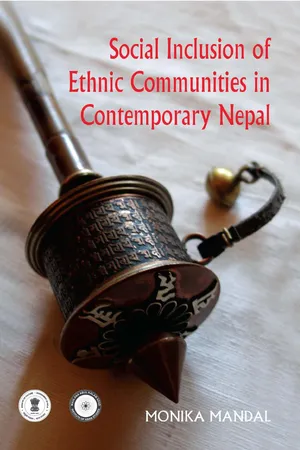
- 458 pages
- English
- ePUB (mobile friendly)
- Available on iOS & Android
About This Book
Social Inclusion of Ethnic Communities in Contemporary Nepal focuses on the dynamics of ethnic identities and movement in South Asian states in a comparative framework. As we witness a series of explosive ethnic revivals across the globe, this study investigates the issues around ethnicity that have come to occupy centre stage in Nepal's contemporary political and development discourse. Nepal is at the crossroads of state building. The Constituent Assembly is now looking into the modalities of establishing a multi-cultural, multi-social, multi-linguistic, multi-religious and multi-ethnic federal state. In the aftermath of the April 2006 Jana Andolan II and the commitment of the ruling political alliance to restructuring Nepal along federal republican lines, the assessment of Nepal's ethnic question from multiple perspectives — political, sociological, economic and spatial — has acquired a new urgency. Ethnic identity is only one part of the problem of ethnicity in Nepal. Federalism therefore has to be conceived of as an exercise in addressing the multiplicity of issues that form the agenda of Nepal's development, so that a politically, socially and economically integrated, dynamic and progressive Nepal emerges from the shadows of the pasThis work includes an intensive analysis of facts, figures and particulars collected from available records and surveys. One of the aims of the study is to assess the defining ethnic identity among the Limbus, centred on a case in an urban area in the Kathmandu Valley. This work is mainly based on qualitative data but quantitative data has also been used to measure various aspects of the community, like the level of educational, economy etc. This volume will be an invaluable guide for the scholars of federalism in Nepal while also educating the lay reader in general.
Frequently asked questions
Information
Table of contents
- Cover
- Half
- Title
- Copyright
- Contents
- Preface and Acknowledgements
- Introduction
- 1. A Comparative Definition: Ethnicity in Nepal within World and South Asian Perspectives
- 2. Historical Perspectives on Ethnic Diversity in Nepal
- 3. The Ethnic Context of Contemporary Nepal
- 4. Ethnic Identity Politics in Nepal
- 5. Spatial Distribution of Population by Mother Tongue and Language Diversity in Nepal
- 6. Ethnic Migration in Nepal
- 7. Socio-Cultural Lifestyle of Ethnic People in Nepal
- 8. Defining Ethnic Identity among the Limbus
- Conclusion
- Appendices
- Bibliography